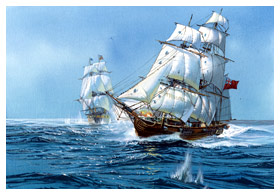 |
 Privateers in the American Revolution
Privateers in the American Revolution
by John Frayler, Salem Maritime National
Historic Site When the American colonies
declared their independence from Great Britain, the infant nation
was in no position to defy British rule of the seas. Britain’s
navy in 1776 was the world’s most powerful. States individually
outfitted vessels of war and Congress established a navy, but it
was a slow beginning. At no point in the conflict did the American
naval forces have adequate resources to confront the Royal Navy
on its own terms. The Royal Navy—once the protector of American
shipping—now made every effort to suppress and destroy it.
The Americans responded to the situation with the time-honored practice
of privateering. American privateering activity during the American
Revolution became an industry born of necessity that encouraged
patriotic private citizens to harass British shipping while risking
their lives and resources for financial gain.
European governments regularly issued documents
known as Letters of Marque and Reprisal to legitimize privately
outfitted men-of-war. In a tradition dating back to the Middle Ages,
under highly regulated conditions, these documents authorized private
parties to attack enemy vessels. Without the documentation, these
same activities were considered acts of piracy and subject to prosecution.
If a privateer captured an enemy ship (known as a prize), an admiralty
prize court had to approve the seizure. Then, the proceeds from
the sale of the prize and its cargo were shared among the owners
and crew of the privateer according to a pre-arranged contract.
Privateering encompassed two levels of participation.
A Letter of Marque authorized armed merchant ships to challenge
any likely enemy vessel that crossed its path during the course
of a commercial voyage. A Privateer Commission was issued to vessels,
called privateers or cruisers, whose primary objective was to disrupt
enemy shipping. The ideal target was an unarmed, or lightly armed,
commercial ship.
With the passage of an act on March 23, 1776, the Continental Congress
formalized the commissioning process, and uniform rules of conduct
were established. Owners of privateers had to post monetary bonds
to ensure their proper conduct under the regulations.
Although the documentation is incomplete, about
1,700 Letters of Marque, issued on a per-voyage basis, were granted
during the American Revolution. Nearly 800 vessels were commissioned
as privateers and are credited with capturing or destroying about
600 British ships.
Vessels of every size and description were
pressed into service as privateers. At the upper end of the scale
was the 600-ton, 26-gun ship Caesar of Boston. At the other
end was the 8-ton boat Defense of Falmouth, Massachusetts.
Crews ranged from a few men in a whaleboat to more than 200 aboard
a large, fully equipped privateer. Two-masted schooners and brigantines
were most often used in privateering, reflecting the kind of vessels
available to American seamen.
Home ports for vessels operating as privateers
and Letters of Marque included Portsmouth, New Hampshire; Boston,
Salem, Beverly and Newburyport in Massachusetts; Philadelphia, Pennsylvania;
Baltimore, Maryland; New London, New Haven, Norwich and Wethersfield,
Connecticut; Providence, Rhode Island; and Richmond, Virginia.
Privateers achieved the best results
if they could bluff an opponent into believing opposition was futile.
When this failed the result was often vicious combat with unpredictable
results. Many privateers were captured or sunk when the odds were
against them. In spite of all the risks and hazards, the overall
effort to cripple Britain's commercial fleet was highly effective,
and fortunes destined to finance the new republic were made. It
is estimated that the total damage to British shipping by American
privateers was about $18 million by the end of the war, or just
over $302 million in today's dollars.
To learn more:
Donald Barr Chidsey, The American Privateers
(New York, N.Y.: Dodd, Mead, 1962)
Edgar Stanton Maclay, A History of American
Privateers (Freeport, N.Y., 1970)
C. Keith Wilbur, Picture Book of the Revolution's
Privateers (Harrisburg, Pa.: Stackpole Books, 1973)
<
back to story listing
|
 |
